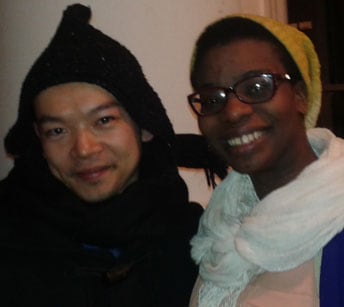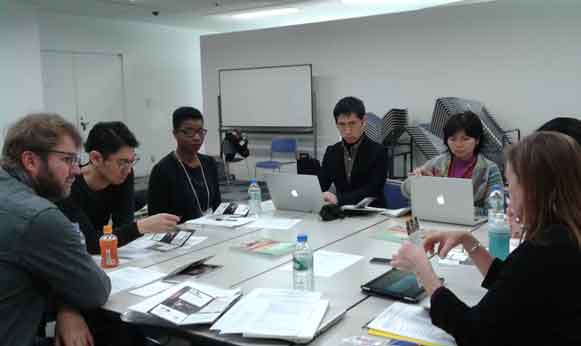Developing an Asian Network
April 15, 2015 • 4 minute read

by Marie Casmir, Associate Director
Links Hall, Chicago
On February 10, 2015 I arrived in Yokohama as part of the U.S. curators team of the NPN’s US-Japan Connection project (Project), joining MK Wegmann (NPN CEO), Kyoko Yoshida (NPN Asia Exchange program consultant), Ron Berry (Fusebox, Austin) and Steve McQueen (Flynn Center for the Performing Arts, Burlington). The main purpose of the trip was to attend the Tokyo Performing Arts Meeting (TPAM), which is the oldest performing arts platform in Asia, celebrating its 20th anniversary this year. Over the course of the next six days we kept ourselves busy attending several intimate and larger network meetings and live performances in various spaces across the city, including large multiplex like spaces (Kanagawa Arts Theater- KAAT), small theaters with floor seating (ST Spot) and the beautifully renovated Red Brick Warehouse on the waterfront. We devoured yakitori and delicious Chinese food (Yokohama has the largest Chinatown in Japan), hopping from one spot to the next in the downtown area.

The Project’s regular meeting took place at the Yokohama Doll Museum, the largest of its kind in Japan. The U.S. team reunited with our Japanese colleagues, Yusuke Hashimoto, program director of the Kyoto Experiment and chair of ON-PAM (Open Network of Performing Arts Managers), Sadayuki Higuchi, secretarial general of Arts NPO Link and Fumi Yokobori, program director of NPO Dance Box.
Succeeding our regular meeting of bi-national partners, we grabbed a quick lunch in Chinatown then moved on to a round table discussion session regarding disaster relief and preparedness in the arts. Moderated by Sadayuki, Ms. Teiko Hinuma, arts educator and producer, who is active in the disaster relief efforts, made an informative presentation. Our stomachs dropped at the photos of a leveled town destroyed by the 3.11 Tsunami. This was a place that now existed only in memory and would have to be completely rebuilt. The effects of the Tsunami coupled with nuclear disaster at Fukushima is very much present in the work of artists and community organizers in Japan. Like many who have felt the impact of a great national loss, they continue with life, creating new spaces for making art and taking on bigger projects, but the echoes of disaster are felt in some of these new projects. MK shared with the group about the lasting effects of Katrina in the Gulf area and how artists and their communities continue to cope and heal economically and socially 10 years later. She made an in-depth presentation to introduce three programs dedicated to disaster relief and/or preparedness in the U.S. nonprofit arts: Transforma, CERF+ (Craft Emergency Relief Fund), and ArtsReady, a program of South Arts. ArtsReady is a web-based emergency preparedness platform designed to provide arts and cultural organizations with customized business continuity plans for post crisis sustainability. The Japanese participants also appreciated the “Studio Protector” wheel, made by CERF+, a physical tool for artists as a reminder to be prepared for action when disaster may strike your livelihood.
Next morning, Ron presented information about the Fusebox Festival and “thinkEAST” project to TPAM participants. Titled as “Social Activism & Performing Arts Festival,” this session gathered over 40 conference attendees. (“thinkEast is a large scale long term project to transform a former Austin tank farm and provide affordable living and working environments for Austin’s creative community.)
This year’s TPAM focused for the first time on work being created and produced across Asia. The organizers are looking to support a stronger network of Asian producers to welcome diversity and working internationally.
The NPN group benefited from this focus as we were able to not only become better acquainted with the work of Japanese artists and producers, but also meet those working in Malaysia, China, the Philippines, Korea and many other counties in Asia. It also allowed us to understand Japan in the bigger historical and geographical background.
We attended a stunning piece from Somatic dance practitioner and technology enthusiast artist Hiroaki Umeda (Japan), and a seductive and politically charged geisha-inspired work-in-progress showing, from the Philippines-based performance artist Eisa Jocson, played to an overflowing audience. More examples of diverse works, both in nationality and in form, included the Japanese premiere of Thai choreographer and Khon master, Pichet Klunchun’s Black and White, and Mika Kurosawa’s JAZZZZZZZZZZZZ Dance featuring 13 independent dancers based in Kobe. (Both programs were curated by our partner, Fumi, as part of the TPAM Direction Series.)
Japanese contemporary arts organizations are looking toward the future and that includes supporting spaces outside of the city centers, with beautiful residency facilities in places like the Kinosaki International Arts Center and co-producing with other countries in Asia and beyond. My preconceptions of Japan being a homogeneous country and rather closed to its neighbors has changed in a very significant way.
I experienced an arts culture that was looking for ways to open to the rest of the continent – to cultures and people that may be considered as other. In the U.S. we continue to struggle and work to create space for artists and producers of color to thrive, NPN being a champion of that cause. I look forward to watching TPAM develop its commitment to diversity.
We returned to our various homes on February 16 (MK arriving just in time for Mardi Gras), each with our findings – the best airport sake, rare vintage Japanese press Jazz records, new bento box for a loved one, and new friends and colleagues. Our inboxes continue to receive the occasional email from artists about their performances in Kobe or Kyoto or Quezon City in the Philippines, etc.
Fast-forward to April, we at Links Hall just received our first visit from our Japanese colleagues: Sachie Tanaka of Dance Box and Eriko Nishitani from the Kyoto Experiment, accompanied by Kyoko Yoshida. In 48 hours they saw a small showcase of five works by Chicago artists, two additional performances in our space, met with 20+ artists and our Chicago-based colleagues, Yolanda Cesta Cursach at MCA, and Phil Reynolds at the Dance Center of Columbia College Chicago. Then off they went to Austin to catch the last five days of the Fusebox Festival. We are certainly excited to continue the exchange of art, ideas and ways to collaborate in a meaningful way that will have a lasting impact for our organizations.
Arigato to all who made the experience possible, jetlag and all.